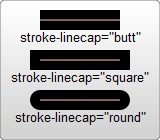填充和描边
填充和描边属性
绘制
可以通过在节点上设置两个属性来完成基本的着色:fill 和 stroke。使用 fill 设置对象内部的颜色,而 stroke 设置围绕对象绘制的线条的颜色。您可以使用与在 HTML 中相同的 CSS 颜色命名方案,无论是颜色名称(如 red)、rgb 值(如 rgb(255 0 0))、十六进制值等。
<?xml version="1.0" standalone="no"?>
<svg width="160" height="140" xmlns="http://www.w3.org/2000/svg" version="1.1">
<rect
x="10"
y="10"
width="100"
height="100"
stroke="blue"
fill="purple"
fill-opacity="0.5"
stroke-opacity="0.8"
stroke-width="15" />
</svg>
此外,您可以在 SVG 中分别指定 fill 或 stroke 的不透明度。这些由 fill-opacity 和 stroke-opacity 属性控制。
描边
除了其颜色属性外,还有其他一些属性可用于控制在线条上绘制描边的方式。

<?xml version="1.0" standalone="no"?>
<svg width="160" height="140" xmlns="http://www.w3.org/2000/svg" version="1.1">
<line x1="40" x2="120" y1="20" y2="20" stroke="black" stroke-width="20" stroke-linecap="butt"/>
<line x1="40" x2="120" y1="60" y2="60" stroke="black" stroke-width="20" stroke-linecap="square"/>
<line x1="40" x2="120" y1="100" y2="100" stroke="black" stroke-width="20" stroke-linecap="round"/>
</svg>
stroke-width 属性定义此描边的宽度。描边围绕路径居中绘制。在上面的示例中,路径显示为粉红色,描边显示为黑色。
第二个影响描边的属性是 stroke-linecap 属性,如上所示。这控制线条末端的形状。
stroke-linecap 有三个可能的值
butt使用与描边方向垂直(90 度)的直边关闭线条,并穿过其末端。square具有基本相同的显示效果,但会将描边稍微延伸到实际路径之外。描边超出路径的距离是stroke-width的一半。round在描边末端产生圆形效果。此曲线的半径也由stroke-width控制。
使用 stroke-linejoin 控制如何绘制两条线段之间的连接。

<?xml version="1.0" standalone="no"?>
<svg width="160" height="280" xmlns="http://www.w3.org/2000/svg" version="1.1">
<polyline points="40 60 80 20 120 60" stroke="black" stroke-width="20"
stroke-linecap="butt" fill="none" stroke-linejoin="miter"/>
<polyline points="40 140 80 100 120 140" stroke="black" stroke-width="20"
stroke-linecap="round" fill="none" stroke-linejoin="round"/>
<polyline points="40 220 80 180 120 220" stroke="black" stroke-width="20"
stroke-linecap="square" fill="none" stroke-linejoin="bevel"/>
</svg>
这些折线每条都有两条线段。两条线段相交处的连接由 stroke-linejoin 属性控制。此属性有三个可能的值。miter 将线条稍微延伸到其正常宽度之外,在只使用一个角度的地方创建一个方形角。round 创建一个圆形的线段。bevel 创建一个新角度以帮助两条线段之间的过渡。
最后,您还可以通过指定 stroke-dasharray 属性在描边上使用虚线类型。

<?xml version="1.0" standalone="no"?>
<svg width="200" height="150" xmlns="http://www.w3.org/2000/svg" version="1.1">
<path d="M 10 75 Q 50 10 100 75 T 190 75" stroke="black"
stroke-linecap="round" stroke-dasharray="5,10,5" fill="none"/>
<path d="M 10 75 L 190 75" stroke="red"
stroke-linecap="round" stroke-width="1" stroke-dasharray="5,5" fill="none"/>
</svg>
stroke-dasharray 属性可以将其参数作为一系列用逗号和/或空格分隔的数字。
第一个数字指定填充区域的距离,第二个数字指定未填充区域的距离。因此,在上面的示例中,第二条路径填充 5 个像素单位,然后是 5 个空白单位,直到下一个 5 个单位的虚线。如果您想要更复杂的虚线图案,可以指定更多数字。第一个示例指定了三个数字,在这种情况下,渲染器会将这些数字循环两次以创建偶数图案。因此,第一条路径渲染 5 个填充、10 个空、5 个填充,然后循环回以创建 5 个空、10 个填充、5 个空。然后图案重复。
还有其他可用的 stroke 和 fill 属性,包括 fill-rule, 它指定如何为自身重叠的形状着色;stroke-miterlimit,它确定描边是否应该绘制斜接;以及 stroke-dashoffset,它指定在线条上开始虚线图案的位置。
绘制顺序
可以使用 paint-order 属性控制填充和描边的绘制顺序。
<?xml version="1.0" standalone="no"?>
<svg width="400" height="180" xmlns="http://www.w3.org/2000/svg" version="1.1">
<polyline
points="40 80 80 40 120 80"
stroke-width="15"
stroke="black"
fill="coral"
paint-order="fill" />
<polyline
points="40 140 80 100 120 140"
stroke-width="15"
stroke="black"
fill="coral"
paint-order="stroke" />
</svg>
对于第一个形状,填充已在描边之前渲染,因此黑色描边出现在填充之上。对于第二个形状,描边已在填充之前渲染。
使用 CSS
除了在对象上设置属性外,您还可以使用 CSS 来设置填充和描边的样式。并非所有属性都可以通过 CSS 设置。处理绘制和填充的属性通常可用,因此 fill、stroke、stroke-dasharray 等都可以通过这种方式设置,此外还有下面显示的这些属性的渐变和图案版本。诸如 width、height 或 <path> 命令之类的属性无法通过 CSS 设置。最简单的方法就是测试并找出哪些可用,哪些不可用。
注意:SVG 规范 严格区分属性和其他属性。前者可以使用 CSS 修改,后者则不能。
CSS 可以通过 style 属性内联到元素中
<rect x="10" height="180" y="10" width="180" style="stroke: black; fill: red;"/>
或者它可以移动到您包含的特殊样式部分。但是,与在 HTML 中的操作不同,您不会将此类部分塞入 <head> 部分,而是将其包含在一个名为 <defs> 的区域中。
<defs> 代表定义,您可以在此处创建不直接出现在 SVG 中但由其他元素使用的元素。
<?xml version="1.0" standalone="no"?>
<svg width="200" height="200" xmlns="http://www.w3.org/2000/svg" version="1.1">
<defs>
<style><![CDATA[
#MyRect {
stroke: black;
fill: red;
paint-order: stroke;
}
]]></style>
</defs>
<rect x="10" height="180" y="10" width="180" id="MyRect"/>
</svg>
将样式移动到这样的区域可以更容易地调整大量元素的属性。您还可以使用诸如:hover伪类之类的功能来创建悬停效果。
#MyRect:hover {
stroke: black;
fill: blue;
}
您还可以通过标准的 XML-stylesheet 语法为 CSS 规则指定外部样式表。
<?xml version="1.0" standalone="no"?>
<?xml-stylesheet type="text/css" href="style.css"?>
<svg width="200" height="150" xmlns="http://www.w3.org/2000/svg" version="1.1">
<rect height="10" width="10" id="MyRect"/>
</svg>
其中style.css看起来像这样
#MyRect {
fill: red;
stroke: black;
}